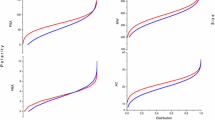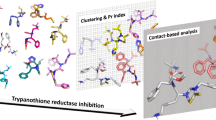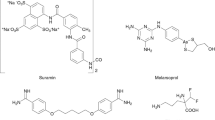Abstract
Chagas disease is caused by the protozoan Trypanosoma cruzi prevalent in the endemic regions of Latin American countries. With the existing drugs having severe toxic side effects, neither a vaccine nor an effective treatment is available for this chronic disease till date. In a pursuit to develop novel drug candidates against Chagas disease, we looked at the vast reservoir of mother nature and built an in-house library of 110 natural plant metabolites from medicinal plants having proven trypanocidal activities. This battery of compounds was examined against T. cruzi trypanothione reductase (1GXF) via computational methods using Autodock. 18-acetoxy-5,6-deoxy-5-withenolide (B.E. = −11.05 kcal/mol) and Sarachine (B.E. = −10.86 kcal/mol) turned out to be the top scorers in this study. Further pharmacophore detection of the high scorers resulted in a hybrid model considering the structural and spatial characteristics of the molecules. This can be further used to generate promising drug candidates aligned for clinical development in the drug design pipeline.


























Similar content being viewed by others
References
Abdel SE, Maes L, Salama MM (2010) In vitro activities of plant extracts from Saudi Arabia against malaria, leishmaniasis, sleeping sickness and chagas disease. Phytother Res 24:1322–1328
Al-Musayeib et al (2012) In vitro antiplasmodial, antileishmanial and antitrypanosomal activities of selected medicinal plants used in the traditional Arabian peninsular region. BMC Complement Altern Med 12:49
Andrade et al (1996) Randomised trial of efficacy of benznidazole in treatment of early Trypanosoma cruzi infection. Lancet 348:1407–1413
Bond CS, Zhang Y, Berriman M, Cunningham ML, Fairlamb AH, Hunter WN (1999) Crystal structure of Trypanosoma cruzi trypanothione reductase in complex with trypanothione, and the structure-based discovery of new natural product inhibitors. Structure 7:81–89
Bringmann G, Messer K, Brun R, Mudogo V (2002) Ancistrocongolines A–D, new naphthylisoquinoline alkaloids from Ancistrocladus congolensis. J Nat Prod 65:1096–1101
Bringmann G, Dreyer M, Kopff H, Rischer H, Wohlfarth M, Hadi HA, Brun R, Meimberg H, Heubl G (2005) Ent-dioncophylleine A and related dehydrogenated naphthylisoquinoline alkaloids, the first Asian dioncophyllaceae-type alkaloids, from the new plant species Ancistrocladus benomensis. J Nat Prod 68:686–690
Buss AD, Butler MS (2010) Natural product chemistry for drug discovery. The Royal Society of Chemistry, Cambridge
Cançado JR (1999) Criteria of Chagas disease cure. Mem Inst Oswaldo Cruz 94:331–336
Chan C, Yin H, Jacqui G, McKie JH, Jaouhari R, Speers P, Douglas KT, Rock PJ, Yardley V, Croft SL, Fairlamb AH (1998) Phenothiazine inhibitors of trypanothione reductase as potential antitrypanosomal and antileishmanial drugs. J Med Chem 41:148–156
Cosconati S, Forli S, Alex LP, Harris R, Goodsell DS, Oslon AJ (2010) Virtual screening with AutoDock: theory and practices. Expert Opin Drug Discov 5:597–607
DaSilvaa DB, Tullib EC, Militaoc GCG, Costa LLV, Pessoac C, Moraesc MO, Albuquerquea S, Siqueirad JM (2009) The antitumoral, trypanocidal and antileishmanial activities of extract and alkaloids isolated from Duguetia furfuracea. Phytomedicine 16:1059–1063
Edilson NK, de Castro-Prado MA (2005) Benznidazole-induced genotoxicity in diploid cells of Aspergillus nidulans. Mem Inst Oswaldo Cruz 100:325–330
Fotie J, Scott D, Olivier M, Gomez MA, Nzimiro S (2007) Trypanocidal and antileishmanial dihydrochelerythrine derivatives from Garcinia lucida. J Nat Prod 70:1650–1653
Garret MM, David SG, Robert SH, Ruth H, William E et al. (1998) Automated docking using Lamarckian genetic algorithm and an empirical binding free energy. J Comput Chem 19:1639–1662
Grayson M (2010) Chagas disease. Nat outlook 465(7301):S3–S22
Jose A, Bravo B, Sauvain M, Gimenez AT, Balanza E, Serani L, Laprevote O, Massiotr G, Lavaud C (2001) Trypanocidal withanolides and withanolide glycosides from Dunalia Brachyacantha. J Nat Prod 64:720–725
Julianti T, Yoshie H, Zimmermann S, Kaiser M, Hamburger M, Adams M (2011) Antitrypanosomal sesquiterpene lactones from Saussurea costus. Fitoterapia 82:955–959
Khan OF (2007) Trypanothione reductase: a viable chemotherapeutic target for antitrypanosomal and antileishmanial drug design. Drug Target Insights 2:129–146
Khan OF et al (2000) Use of an additional hydrophobic binding site, the Z Site, in the rational drug design of a new class of stronger trypanothione reductase inhibitor, quaternary alkylammonium phenothiazines. J Med Chem 43:3148–3156
Krauth-Siegel LR (1996) Crystal structure of the Trypanosoma cruzi trypanothione reductase mepacrine complex. Proteins 24:73–80
Krauth-Siegel LR, Inhoff O (2003) Parasite specific trypanothione reductase as a drug target molecule. Parasitol Res 90:S77–S85
Lacroix D, Prado S, Kamoga D, Kasenene J, Bodo B (2011) Structure and in vitro antiparasitic activity of constituents of Citropsis articulata root bark. J Nat Prod 74:2286–2289
Lai H, Prasad GS, Padmanabhan R (2013) Characterization of 8-hydroxyquinoline derivatives containing aminobenzothiazole as inhibitors of dengue virus type 2 protease in vitro. Antivir Res 97:74–80
Meiering S, Inhoff O, Mies J, Vincek A, Garcia G, Kramer B, Dormeyer M, Krauth-Siegel RL (2005) Inhibitors of Trypanosoma cruzi trypanothione reductase revealed by virtual screening and parallel synthesis. J Med Chem 48:4793–4802
Mendoza DT, Luis D, Gonzalez U, Barria EO, Todd LC, Rios LC (2003) Five new cassane diterpenes from Myrospermum frutescens with activity against Trypanosoma cruzi. J Nat Prod 66:928–932
Morel CM (2000) Reaching maturity-25 years of the TDR. Parasitol Today 16:522–525
Moretti C, Sauvain M, Lavaud C, Massiot G, Bravo JA, Munoz V (1998) A novel antiprotozoal aminosteroid from Saracha punctate. J Nat Prod 61:1390–1393
Morris GM, Goodsell DS et al (1998) Automated docking using a Lamarckian genetic algorithm and empirical binding free energy function. J Comput Chem 19:1639–1662
Muller S, Liebau E, Walter RD, Krauth-Siegel RL (2003) Thiol-based redox metabolism of protozoan parasites. Trends Parasitol 19:7
Saravanamuthu A, Vickers TJ, Bond CS, Peterson MR, Hunter WN, Fairlamb AH (2004) Two Interacting binding sites for quinacrine derivatives in the active site of trypanothione reductase. J Biol Chem 279:29493–29500
Scio E, Ribeiro A, Tania MA, Romanha AJ, Shin YG, Cordell GA, Zani CL (2003) New bioactive coumarins from Kielmeyera albopunctata. J Nat Prod 66:634–637
Sosa ES, Segura EL (1999) Treatment of Trypanosoma cruzi infection in the undetermined phase experience and current guidelines in Argentina. Mem Inst Oswaldo Cruz 94:363–365
Sosa ES, Segura EL, Ruiz AM, Velazquez E, Porcel BM, Yampotis C (1998) Efficacy of chemotherapy with benznidazole in children in the indeterminate phase of chagas disease . Am J Trop Med Hyg 59:526–529
WHO report on neglected tropical diseases: working to overcome the global impact of neglected tropical diseases (2010) (NLM Classification: WC 680). ISBN 9789241564090
Acknowledgments
The authors are grateful to CSIR (Grant No. CSR-724-CMD) for financial support. One of the authors (D.S.) is thankful to MHRD for the award of fellowship.
Author information
Authors and Affiliations
Corresponding author
Electronic supplementary material
Below is the link to the electronic supplementary material.
Rights and permissions
About this article
Cite this article
Saha, D., Sharma, A. Docking-based screening of natural product database in quest for dual site inhibitors of Trypanosoma cruzi trypanothione reductase (TcTR). Med Chem Res 24, 316–333 (2015). https://doi.org/10.1007/s00044-014-1122-x
Received:
Accepted:
Published:
Issue Date:
DOI: https://doi.org/10.1007/s00044-014-1122-x




